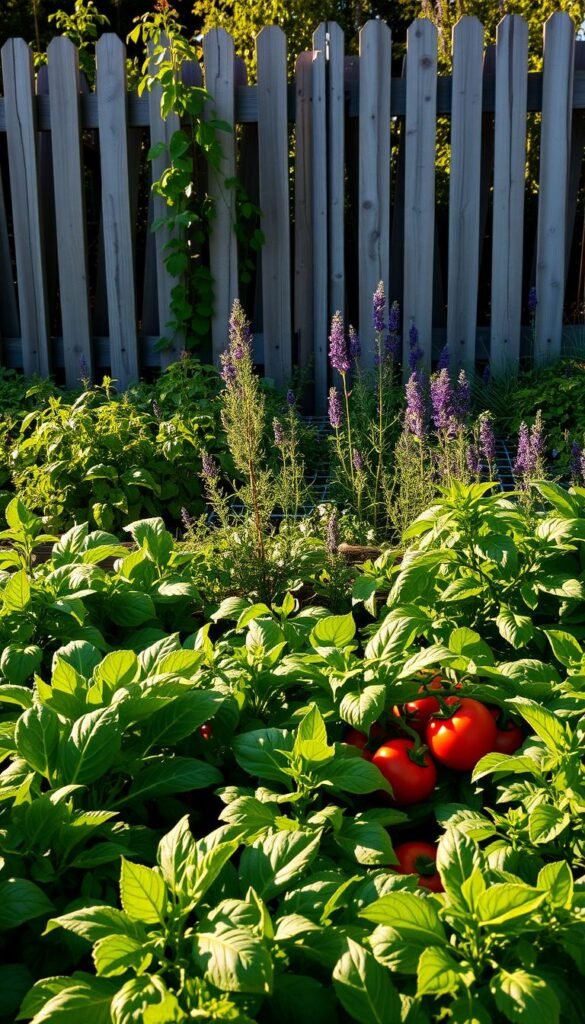Nothing beats biting into a sun-warmed tomato you nurtured from seed. But creating that perfect patch of green goodness takes more than luck – it’s about strategic friendships between your plants. Imagine your peppers cheering on your basil, or marigolds standing guard against pests. That’s the magic of pairing plants purposefully.
You’ll soon discover how certain combinations boost growth naturally. Take tomatoes thriving near basil, or cucumbers protected by nasturtiums. These partnerships aren’t random – they’re nature’s blueprint for healthier crops. Even small spaces shine when you organize plants using smart spacing techniques.
This guide reveals simple ways to design your green space like a pro. We’ll show how yarrow fights aphids, why carrots love onions, and how the classic “Three Sisters” trio (corn, beans, squash) supports itself. You’ll learn to work with nature instead of against it – saving time while growing tastier veggies.
Ready to transform your backyard into a buzzing ecosystem? Let’s dig into the plant pairings that deliver bigger harvests with fewer headaches. Your future self will thank you when you’re swapping zucchini with neighbors instead of battling beetles!
Welcome to Your Companion Planting Journey
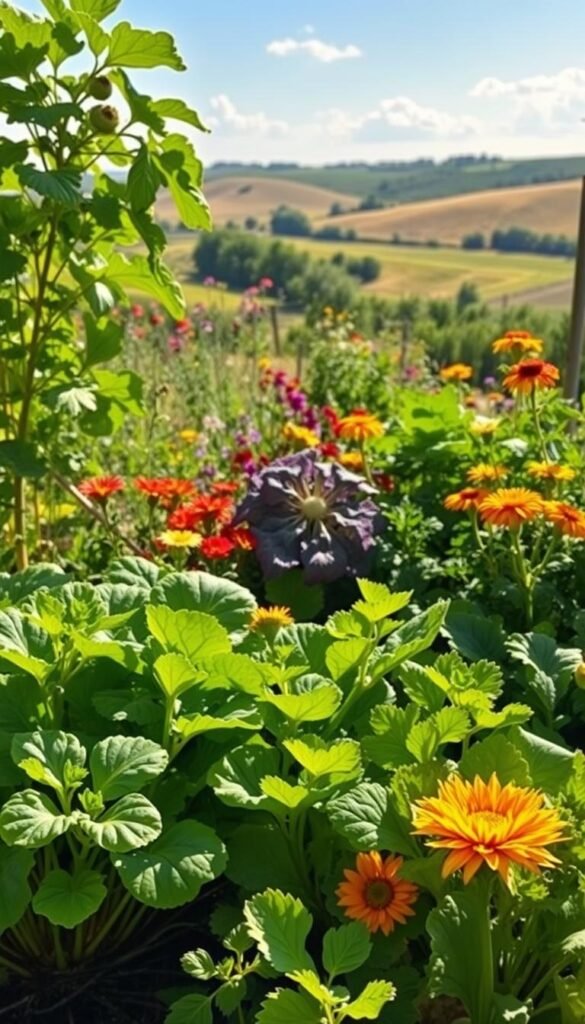
Picture your tomatoes sharing nutrients with carrots while marigolds fend off hungry bugs. This isn’t fantasy – it’s nature’s teamwork in action. Strategic plant pairings create living support systems that make your vegetables thrive with less effort.
Nature’s Recipe for Better Harvests
Science proves what gardeners have known for centuries. Studies show certain plant combinations boost yields by nearly one-third. Marigolds release soil chemicals that repel root-eating nematodes, while basil makes tomatoes taste sweeter by reducing pest stress.
Here’s the kicker: these partnerships work year-round. As you’ll see in our guide to stronger, healthier plants through the seasons, smart pairings adapt to weather changes. Nasturtiums shield cucumbers from summer beetles, then winter rye preps soil for spring peas.
The Art of Garden Harmony
Think of your plot as a puzzle where every piece supports others. Tall corn shelters shade-loving lettuce. Deep-rooted dill pulls nutrients up for shallow herbs. Even weeds get managed when clover carpets empty spaces.
“Plants talk through their roots,” notes urban farmer Lena Rodriguez. “When we listen, they tell us who makes good neighbors.” This underground network prevents nutrient fights while creating natural mulch from fallen leaves.
You’ll soon spot patterns: aromatic herbs confuse pests, flowers attract pollinators, and nitrogen-fixers feed heavy feeders. These relationships transform your space into a self-sustaining ecosystem where every plant pulls double duty.
Understanding Light and Space in Your Veggie Garden
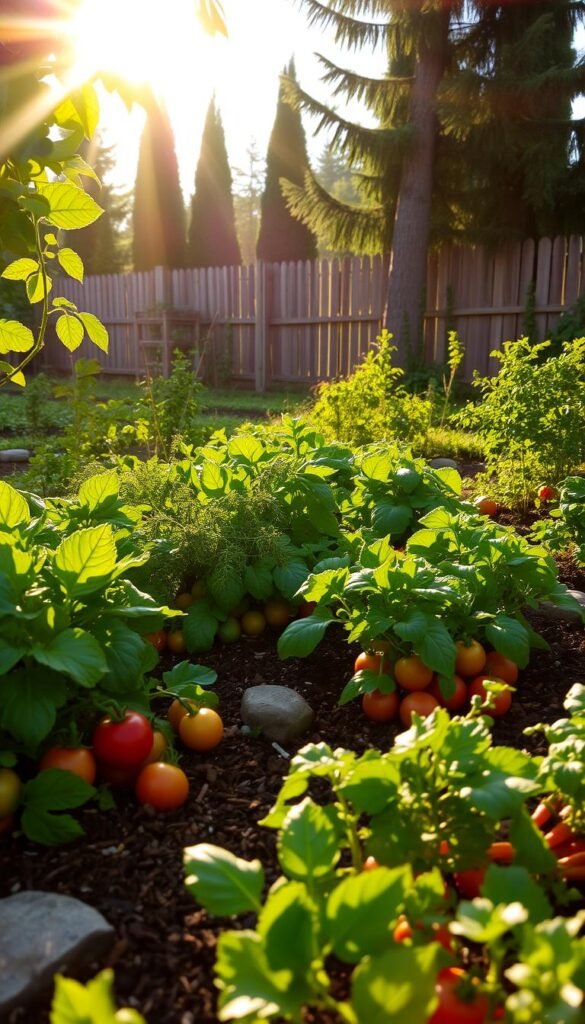
Your plants’ performance depends on their spotlight and stage setup. Track sun patterns like a director watching rehearsals – some crops crave front-row brightness while others thrive in the wings.
Sunlight Mapping Made Simple
Use your phone to photograph shadows every two hours. Full sun areas host tomatoes and peppers. Partial shade spots work for leafy greens. Watch how light shifts through seasons – spring sun differs from July’s intensity.
Smart Space Solutions
Raised beds boost yields by keeping roots warm and weeds out. Try this layout for 4×8 foot beds:
| Vegetable | Sun Needs | Space Tips |
|---|---|---|
| Tomatoes | 6-8 hours | 18″ between plants |
| Lettuce | 3-5 hours | 6″ spacing |
| Peppers | 6+ hours | 12″ apart |
| Cucumbers | 6-8 hours | Vertical trellis |
| Spinach | 3-4 hours | Succession plant |
Pair sun-loving crops with vertical growers like pole beans. Even tiny yards flourish using space-maximizing tricks like stacking planters or hanging baskets.
Remember: Overcrowding steals sunlight and invites disease. Give each plant room to bask – your harvests will show the difference!
Choosing the Right Plants for Your Garden
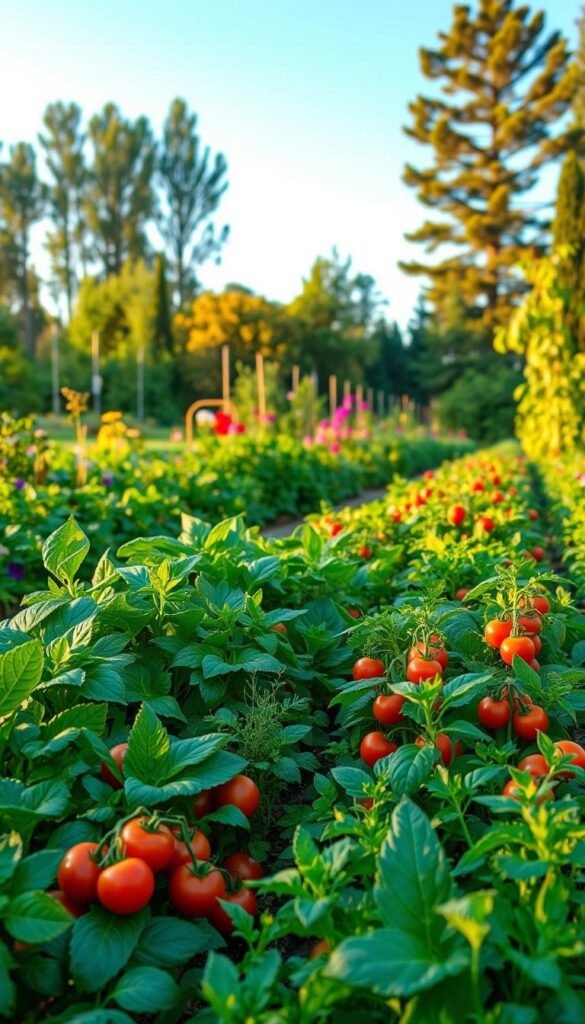
Think of your garden as a dinner party – some guests get along famously, while others clash like oil and water. Matching the right plants creates thriving communities where everyone benefits. Let’s explore which veggies make perfect neighbors and which ones need separate tables.
Vegetable Matchmaking Made Simple
Popular crops have clear preferences for their growing partners. Tomatoes adore basil’s pest-repelling scent but wilt near potatoes. Peppers thrive beside carrots but struggle with fennel. Check this cheat sheet for top pairings:
| Vegetable | Best Friends | Avoid Planting With |
|---|---|---|
| Tomatoes | Basil, carrots, onions | Potatoes, cabbage |
| Cucumbers | Corn, peas, marigolds | Mint, sage |
| Peppers | Eggplant, asparagus | Beans, broccoli |
| Lettuce | Strawberries, radishes | Parsley, beans |
Herbs & Flowers: The Secret Sauce
Don’t just grow food – grow protectors! Marigolds deter nematodes near tomatoes, while nasturtiums lure aphids away from beans. Herbs like oregano boost flavor in nearby veggies while confusing pests with strong scents.
Even small spaces shine when you mix edibles and flowers in container. Try basil with cherry tomatoes in pots, or chives circling pepper plants. These partnerships work overtime – they feed your family and support your garden’s health!
Balanced Veggie Garden Layout: Companion Planting for Success
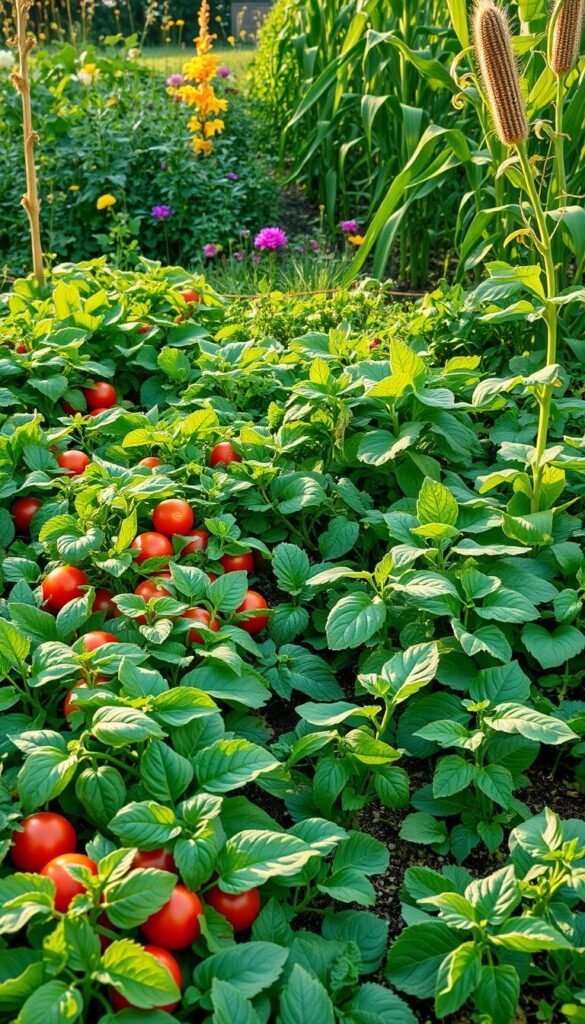
Your vegetable patch becomes a powerhouse when plants work together above and below ground. Smart arrangements let crops share resources while keeping soil lively and productive. Let’s explore two game-changing approaches that turn your plot into a well-oiled ecosystem.
Time-Saving Plant Partnerships
Intercropping pairs speedy growers with slowpokes for nonstop harvests. Tuck quick-maturing radishes between tomato seedlings – you’ll pull the roots before the vines need space. Try this winning combo table:
| Fast Crop | Slow Crop | Benefit |
|---|---|---|
| Lettuce | Peppers | Shade keeps soil cool |
| Spinach | Eggplant | Early harvest clears space |
| Green onions | Cabbage | Repels cabbage moths |
Group plants in blocks using square foot principles for easy care. Keep heavy feeders like corn separate from light eaters like herbs. This setup simplifies crop rotation later.
Soil Renewal Through Smart Swaps
Rotate plant families yearly to keep earth bursting with life. Follow this three-year cycle:
| Year 1 | Year 2 | Year 3 |
|---|---|---|
| Tomatoes | Beans | Leafy greens |
| Peppers | Peas | Root vegetables |
Legumes fix nitrogen for next year’s hungry crops. Deep-rooted carrots break up compacted dirt, letting water reach further. Always leave space for plants to breathe – crowded beds invite trouble.
These strategies create self-sustaining systems where plants feed the soil as they grow. Your dirt stays rich, pests stay confused, and harvests keep coming!
Creative Garden Design Ideas
Transform your edible plot into a living masterpiece that feeds both body and soul. Strategic arrangements boost plant health while creating eye-catching displays. Let’s explore three design approaches that marry beauty with bounty.
Sun-Smart Spatial Planning
Arrange crops in north-south rows for maximum light exposure. Place tall sunflowers or corn at the northern edge, with medium-height peppers in the middle. Leafy greens thrive at the southern end. This tiered setup lets every plant soak up rays without shading neighbors.
Sky-High Growing Solutions
Stack planters or install trellises when ground space shrinks. Pole beans climb tomato cages prettily, while strawberries spill from hanging baskets. Even patios flourish with container setups pairing herbs with compact veggies like cherry tomatoes.
Colorful Edible Artistry
Mix textures and hues for visual pop. Purple basil contrasts golden marigolds, while frilly carrot tops play against chive blossoms. Red lettuce varieties create living borders around pepper plants. These combos delight pollinators too!
Your green space becomes both gallery and grocer when design meets function. Experiment with patterns, heights, and partnerships – nature rewards creativity with fuller harvests and fewer pests. What vibrant vision will you grow next?

